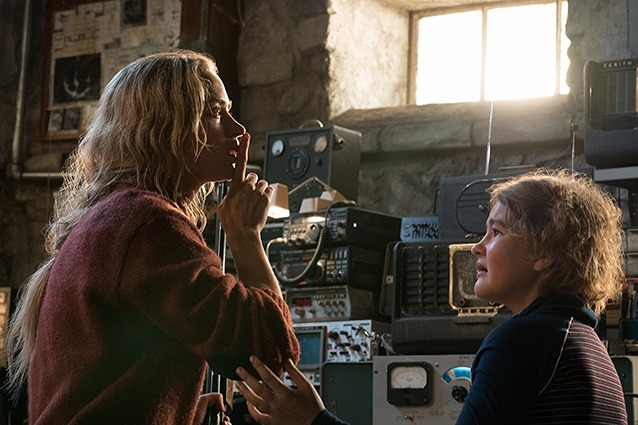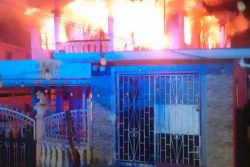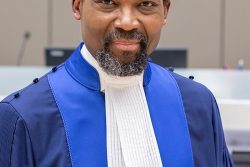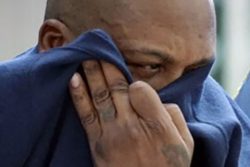![]() The very last moment in John Krasinski’s “A Quiet Place” rests on the deployment of a sound cue that made me want to stand up and cheer, even amidst the troubling implications it raised. The placement of said sound cue in relation to the actions of the film’s final shot is overwhelming for the surety with which it’s presented. It feels, very much, like a moment the movie has been working up to. I won’t spoil the context or the content of the shot or the sound-cue, but in discussing “A Quiet Place,” a movie that depends on the cultivation of silence both within and without the frames, I feel compelled to discuss its relationship with sound.
The very last moment in John Krasinski’s “A Quiet Place” rests on the deployment of a sound cue that made me want to stand up and cheer, even amidst the troubling implications it raised. The placement of said sound cue in relation to the actions of the film’s final shot is overwhelming for the surety with which it’s presented. It feels, very much, like a moment the movie has been working up to. I won’t spoil the context or the content of the shot or the sound-cue, but in discussing “A Quiet Place,” a movie that depends on the cultivation of silence both within and without the frames, I feel compelled to discuss its relationship with sound.
The film is of the post-apocalyptic horror variety. We enter the world via title-card. It is Day 89 in the year 2020. In bits and pieces, we realise that silence is essential in this world. Even before we are shown this explicitly, the film deftly sets up those stakes. Our focus is a family of five, the two parents and their three children. We meet them as they raid a store in a deserted town. The quickness with which we are introduced to the need for silence is the film’s best trick. In this way, “A Quiet Place,” like the most effective of thrillers, enlists the participation of the audience in its anti-sound agenda. You could feel the audience in the theatre particularly keyed into this state, waiting with bated breath for any moment of release. And, true to form, the silence that pervades the film is essential for punctuated moments of sound that come to provide relief, release, and then new complications.
After a short prologue, the story moves ahead to a year later as the family inexplicably prepares for the birth of a new child. “A Quiet Place” never interrogates its characters for this particular point, which leaves its audience to speculate. And so the pregnancy, in a world where a child is an obvious liability, has been read as a pro-life stance, as indicative of the way grief clouds our judgement, or of the film’s inability to be realistic. If I said, the reasoning is irrelevant – would that seem a copout? A great deal of “A Quiet Place” relies on suggestion instead of representation. The larger than life creatures that terrify the family are suggested for most of their appearance, so that by the time we see them in full the effect is discomfiting. Similarly, the family at the centre represent the world but also represent their own idiosyncrasies. In a brief scene, we learn that they are not the only ones in the world, so somewhere out there it’s likely that there are other families struggling with silence. But “A Quiet Place” seems less interesting when read as a representation of everyone, rather than the story of a singular family coming apart at the seams after a tragedy.
Real-life couple Emily Blunt and John Krasinksi play the parents, Evelyn and Lee Abbott, and they are ably supported by Millicent Simmonds and Noah Jupe as the two main children, Regan, who is deaf, and Marcus. The film’s gender representation has come under scrutiny, and it’s a conversation worth having although the final shot of the film seems to argue that the conventions set up early are deliberately being present for their eventual subversion. The parents here are imperfect and sometimes even harmful in the way their grief affects their relationship with their children, and it’s what makes the film’s central argument of parenting as sacrifice most effective. The trepidation that Regan’s parents feel about her deafness making her a liability in this dangerous world, for example, becomes a key part of her deafness being the thing that saves her. The arc is made all the more striking for casting Simmonds, who is deaf, in the role. The entire cast is excellent, but Blunt – one of the most compelling actors working today – is most efficient and effective. She does with her eyes more than some actors do with a sentence. She’s the film’s most dangerous weapon, and Krasinksi (the film’s director and co-writer) knows this.
Weeks have passed and I’m still uncertain where I stand on the officious score that peppers the film. Would the film be more horrific without the non-diegetic sound seeping in to give us emotional context cues? Probably. Certainly. But Krasinski, in key bits, leans into providing comfort and cues for his audience. The score becomes an aural comfort tool for audiences who can filter their nervousness through the emotions it predicts and incurs. It’s why I keep thinking about the way the most effective shots of the film are all signals for the audience to prepare for sound cues that will be devastating when they come. A shot of a toy rocket, with its batteries close by. A shot of an alarm clock. A shot of a nail, exposed. A shot of a rifle. These shots all prepare us for the sounds they will emit. In this way, Krasinski saves us from the jarring surprise that would come if we were not prepared for them. But in this way, Krasinksi also prepares us for tension before tension even becomes part of the film’s fabric. And by preparing for tension we spend more time being tense. The most effective thing the score does is guide the audience until we realise that it is guiding us into fear, too. Its comfort is not total; it’s inconsistent and ultimately false. Just like the shots of those sound cues end up making us tenser as we anticipate them. In this case, foreknowledge does not save us, it just means that we face the imminent terror with awareness.
And, so I return to that final shot. The central ideology of the film’s ending is effective because of how it avoids singular readings. Horror as a genre benefits from the philosophical readings of it. It’s why horror films so often tend to pull from the religious tool-book. “A Quiet Place” is not as in interested in religiosity as, say, “The Exorcist” but the question the film asks, even if subtly, is valuable. In the face of potential, and even certain, destruction, do we load our guns ready to go down in a blaze of glory or do we hide in the crevices putting off the inevitable until delays become unsustainable? Certainly, this philosophical question might not be hammered into the audience. The film turns on focused attention rather than its expansive nods. But, it’s delightful paradox of “A Quiet Place.” The best moments depend on the silence broken by sound. Like a bloodcurdling scream. Like the blasting of fireworks in the sky. And like that final sound cue. Krasinski is conscious of the value of silence because he knows that an environment of silence makes sound more effective when it comes.










